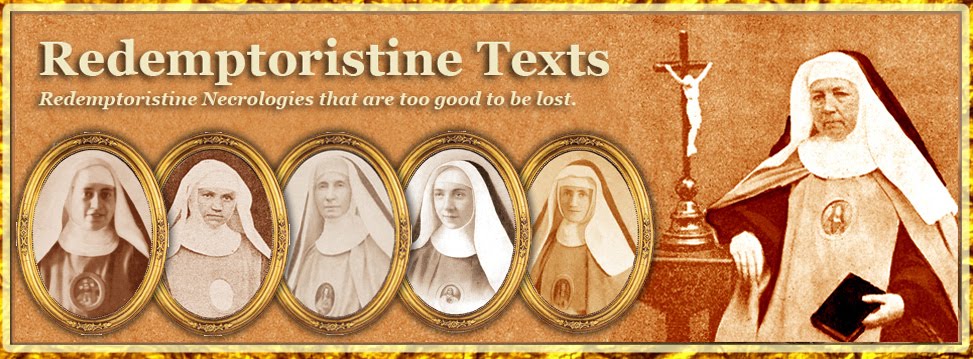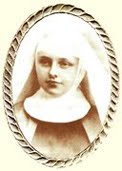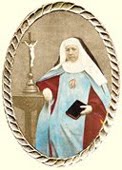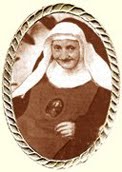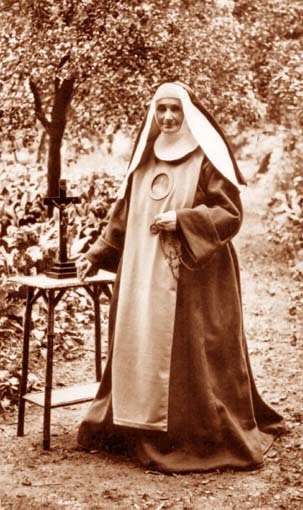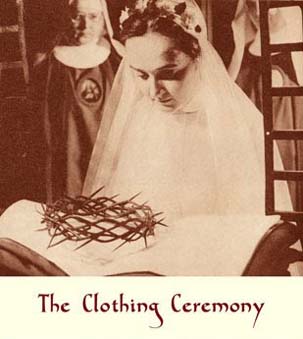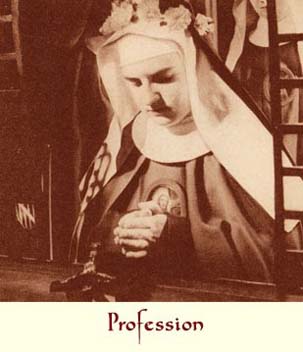Foundation of the Convent of the Redemptoristines at Ried (Upper Austria), in 1858
The Convent of the Redemptoristines of Saint Anne of Ried [1] is rightly called the fruit of the sacrifices, tears and prayers of the Redemptoristines of Vienna. Driven out by the Revolution, these fervent religious had to leave their peaceful home on 6th April 1848 and look for a refuge, some with their families, and others in other convents further afield. And also, like the hart thirsting after a spring of refreshing water, this dear Community wished for nothing other than to reconstitute itself anew. But Providence, which is always at hand, did not remain deaf to the sighs of the exiles.
In March 1851, one of the religious learnt through one of her relatives that at Ried, in Upper Austria, there was a house for sale with an adjoining church. The inhabitants desired to see the establishment of a community of religious there. The clergy were also interested in this matter. Consequently, the necessary applications were begun immediately. Mons. Ziegler expressed it thus: “Since I have not been able to attract the sons of Saint Alphonsus to my diocese, I desire to receive his daughters here.” Pius IX himself entered into the matter and wrote about it to the Bishop of Linz.
However, the enemy of all good placed a thousand obstacles in the way of the realisation of this project, and everything seemed destined to fail. But this was when God showed Himself. His hand visibly conducted this work, and on 23rd August 1852, the Emperor Franz-Joseph signed the authorisation needed for the establishment of this convent. On 15th October, they proceeded to the solemn blessing of the house. Mons. Schiedermayer, surrounded by a dozen priests, officiated pontifically in the presence of a dense crowd. The parish priest of Ried, Father Brelsmayer, at once showed himself favourable to the foundation, and deservedly acquired the name of founder of the convent. A truly holy priest, he was charged by his Bishop with the direction of the Community, and fulfilled his duties of Chaplain to the general satisfaction. God blessed his work. His apostolic words attracted such a crowd of the faithful into our church on Sundays that it became too small. This chapel attracted admirers. Count Arko enriched it with a magnificent painting by Strasser that even to this day decorates the master altar.
However, the house, formerly an asylum for lepers, was a very poor one. The roof was in such a pitiful state that the religious found themselves obliged to open their umbrellas in order to protect their beds against rain or snow. This evil was remedied only gradually, as funds were lacking. Everything had been spent on the purchase of a parcel of land, which was indispensable for the growth of the convent. In addition, it had been impossible to bring anything from Vienna, as the revolutionaries had destroyed everything, including the pictures of the saints themselves. All in all, there remained for Ried no more than a poor florin! And with this they had to provide for the support of six religious!
In her distress, Reverend Mother Maria-Victoria of Jesus, born Countess Welsersheimb, prostrate at the foot of the tabernacle, expressed her distress to the good Master. She had scarcely terminated her prayers when a basket was brought to the Monastery full of bread and other provisions. Moreover, the divine Host permitted a young child, who had heard people talking about the nuns, to become bold enough to want to see their poverty for himself. Profiting from a favourable moment, he secretly penetrated the enclosure, and after a sufficient examination, he escaped in all haste. He made the extreme poverty of the good religious known, and his account made such an impression in the town and beyond, that he provoked a compassionate generosity. Gifts arrived from different directions. The Emperor Ferdinand, the Counts Welsersheimb and von Arko, and Baron von Lago became the benefactors of the house. The venerable Servant of God, Mons. Rudiger, having been able to take stock, on the occasion of a taking of the habit, of the great poverty of the Monastery, also sent some help. It was thanks to these generous gifts that it was possible to finish the building in October 1853.
However, they still suffered from the rigorous coldness of winter, as wood was lacking to dry out the new walls. In addition, a furious tempest in one fell swoop demolished the enclosure of wooden planks, and took 8000 tiles off the roof. These new setbacks made them doubt the possibility of a definitive establishment at Ried. In 1857, the situation was again so sad that Reverend Mother Maria-Victoria believed it to be her duty to write about it to His Holiness. Always supportive, Pius IX responded to her request with a beautiful letter preserved in the archives of the convent. He encouraged the Religious, and exhorted them to confidence and perseverance, but especially to tend more and more to perfection. He blessed them and promised them his prayers. The Sisters felt great joy because of it, and, inspired to a new courage, they continued to struggle on. God rewarded their confidence.
In 1860, Mons. Hagn, the Abbot of the Benedictines of Lambach, became the Vicar General of the diocese. Having obtained authorisation to establish a cemetery in the enclosure, he wished to give the benediction of it himself. They immediately brought in the remains of two Sisters, who had previously been interred in the town cemetery. In 1862, the church was enriched with two magnificent windows, and a Way of the Cross, a new Gothic altar, a pulpit and other embellishments. The wooden enclosure was replaced by a solid wall. Finally, in 1867, the convent, now that it had been finished, was able to house the number of religious required by the Rule.
Nothing was dearer to the good Superior than to see the house of the Lord decently furnished. Although the church was not her property, she was always careful to employ the charitable gifts that came her way to a pious end. In 1905 they proceeded to its decoration. Under the able direction of Mr. Schrems, the paintings were harmonised with the colours of the windows. Between the columns, upon the walls, Mr. Streikner, the religiously inspired artist, in his first painting displayed the divine Saviour giving Himself to the soul in Holy Communion. Another painting represented Saint Francis of Assisi who, disdaining the world, gives himself to his divine crucified Lord, who detaches His arm from the cross and embraces him lovingly. Then it is the Patriarch of monks, Saint Benedict, full of a sweet gravity, surrounded on the right and left side by Saint Maurus and Saint Placidus. Saint Gerard Majella has his place before the choir. He contemplates Jesus crucified, is consumed with love and is pouring out abundant tears.
The choir of the religious was also decorated with beautiful paintings. First of all you see the image of the founder, Saint Alphonsus. Plunged into a profound meditation, the artist shows him in the attitude of editing the Rules and Constitutions. Before him he has Saint Francis of Assisi, absorbed in contemplation, Saint Francis de Paul, Saint Dominic armed with the Rosary, and Saint Augustine enraptured in the presence of the Blessed Sacrament. A little further on there is Saint Francis de Sales, whom the Redemptorists must honour, because of the numerous points in their Rule borrowed from the Constitutions of the Visitation. Another picture represents the divine Mother with the Child Jesus. Her eyes are saddened by the fear of seeing her Son escaping from her. Then comes Saint Gertrude, totally absorbed in Jesus whom she bears on her heart, then Saint Mechtilde, with her eyes questioning heaven, from which she receives the revelations consigned to the book which she holds in her hands. Above the door, you can see the Sacred Heart and the blessed Marguerite-Mary. At the back there is a painting representing the Annunciation, and then two escutcheons bear the arms of the Most Holy Redeemer and the Eye of God, which recalls His presence in every place.
How much people love to visit this pious church! Early in the morning, or to greet the evening, but especially on Sundays, a large number of people come for the recitation of the Rosary. On days of the taking of the habit or of religious profession, a numerous public crowds to the grille, to see the touching ceremony as closely as possible, which is presided over by Mons. Baumgartner, the Chaplain of the convent. We should not forget that it was this worthy priest who had a retreat house for ecclesiastics constructed near the Monastery. It is to him also that we owe the beautiful Calvary in the cemetery, and the tombstones on which are engraved the names of our dear deceased Sisters.
In March 1851, one of the religious learnt through one of her relatives that at Ried, in Upper Austria, there was a house for sale with an adjoining church. The inhabitants desired to see the establishment of a community of religious there. The clergy were also interested in this matter. Consequently, the necessary applications were begun immediately. Mons. Ziegler expressed it thus: “Since I have not been able to attract the sons of Saint Alphonsus to my diocese, I desire to receive his daughters here.” Pius IX himself entered into the matter and wrote about it to the Bishop of Linz.
However, the enemy of all good placed a thousand obstacles in the way of the realisation of this project, and everything seemed destined to fail. But this was when God showed Himself. His hand visibly conducted this work, and on 23rd August 1852, the Emperor Franz-Joseph signed the authorisation needed for the establishment of this convent. On 15th October, they proceeded to the solemn blessing of the house. Mons. Schiedermayer, surrounded by a dozen priests, officiated pontifically in the presence of a dense crowd. The parish priest of Ried, Father Brelsmayer, at once showed himself favourable to the foundation, and deservedly acquired the name of founder of the convent. A truly holy priest, he was charged by his Bishop with the direction of the Community, and fulfilled his duties of Chaplain to the general satisfaction. God blessed his work. His apostolic words attracted such a crowd of the faithful into our church on Sundays that it became too small. This chapel attracted admirers. Count Arko enriched it with a magnificent painting by Strasser that even to this day decorates the master altar.
However, the house, formerly an asylum for lepers, was a very poor one. The roof was in such a pitiful state that the religious found themselves obliged to open their umbrellas in order to protect their beds against rain or snow. This evil was remedied only gradually, as funds were lacking. Everything had been spent on the purchase of a parcel of land, which was indispensable for the growth of the convent. In addition, it had been impossible to bring anything from Vienna, as the revolutionaries had destroyed everything, including the pictures of the saints themselves. All in all, there remained for Ried no more than a poor florin! And with this they had to provide for the support of six religious!
In her distress, Reverend Mother Maria-Victoria of Jesus, born Countess Welsersheimb, prostrate at the foot of the tabernacle, expressed her distress to the good Master. She had scarcely terminated her prayers when a basket was brought to the Monastery full of bread and other provisions. Moreover, the divine Host permitted a young child, who had heard people talking about the nuns, to become bold enough to want to see their poverty for himself. Profiting from a favourable moment, he secretly penetrated the enclosure, and after a sufficient examination, he escaped in all haste. He made the extreme poverty of the good religious known, and his account made such an impression in the town and beyond, that he provoked a compassionate generosity. Gifts arrived from different directions. The Emperor Ferdinand, the Counts Welsersheimb and von Arko, and Baron von Lago became the benefactors of the house. The venerable Servant of God, Mons. Rudiger, having been able to take stock, on the occasion of a taking of the habit, of the great poverty of the Monastery, also sent some help. It was thanks to these generous gifts that it was possible to finish the building in October 1853.
However, they still suffered from the rigorous coldness of winter, as wood was lacking to dry out the new walls. In addition, a furious tempest in one fell swoop demolished the enclosure of wooden planks, and took 8000 tiles off the roof. These new setbacks made them doubt the possibility of a definitive establishment at Ried. In 1857, the situation was again so sad that Reverend Mother Maria-Victoria believed it to be her duty to write about it to His Holiness. Always supportive, Pius IX responded to her request with a beautiful letter preserved in the archives of the convent. He encouraged the Religious, and exhorted them to confidence and perseverance, but especially to tend more and more to perfection. He blessed them and promised them his prayers. The Sisters felt great joy because of it, and, inspired to a new courage, they continued to struggle on. God rewarded their confidence.
In 1860, Mons. Hagn, the Abbot of the Benedictines of Lambach, became the Vicar General of the diocese. Having obtained authorisation to establish a cemetery in the enclosure, he wished to give the benediction of it himself. They immediately brought in the remains of two Sisters, who had previously been interred in the town cemetery. In 1862, the church was enriched with two magnificent windows, and a Way of the Cross, a new Gothic altar, a pulpit and other embellishments. The wooden enclosure was replaced by a solid wall. Finally, in 1867, the convent, now that it had been finished, was able to house the number of religious required by the Rule.
Nothing was dearer to the good Superior than to see the house of the Lord decently furnished. Although the church was not her property, she was always careful to employ the charitable gifts that came her way to a pious end. In 1905 they proceeded to its decoration. Under the able direction of Mr. Schrems, the paintings were harmonised with the colours of the windows. Between the columns, upon the walls, Mr. Streikner, the religiously inspired artist, in his first painting displayed the divine Saviour giving Himself to the soul in Holy Communion. Another painting represented Saint Francis of Assisi who, disdaining the world, gives himself to his divine crucified Lord, who detaches His arm from the cross and embraces him lovingly. Then it is the Patriarch of monks, Saint Benedict, full of a sweet gravity, surrounded on the right and left side by Saint Maurus and Saint Placidus. Saint Gerard Majella has his place before the choir. He contemplates Jesus crucified, is consumed with love and is pouring out abundant tears.
The choir of the religious was also decorated with beautiful paintings. First of all you see the image of the founder, Saint Alphonsus. Plunged into a profound meditation, the artist shows him in the attitude of editing the Rules and Constitutions. Before him he has Saint Francis of Assisi, absorbed in contemplation, Saint Francis de Paul, Saint Dominic armed with the Rosary, and Saint Augustine enraptured in the presence of the Blessed Sacrament. A little further on there is Saint Francis de Sales, whom the Redemptorists must honour, because of the numerous points in their Rule borrowed from the Constitutions of the Visitation. Another picture represents the divine Mother with the Child Jesus. Her eyes are saddened by the fear of seeing her Son escaping from her. Then comes Saint Gertrude, totally absorbed in Jesus whom she bears on her heart, then Saint Mechtilde, with her eyes questioning heaven, from which she receives the revelations consigned to the book which she holds in her hands. Above the door, you can see the Sacred Heart and the blessed Marguerite-Mary. At the back there is a painting representing the Annunciation, and then two escutcheons bear the arms of the Most Holy Redeemer and the Eye of God, which recalls His presence in every place.
How much people love to visit this pious church! Early in the morning, or to greet the evening, but especially on Sundays, a large number of people come for the recitation of the Rosary. On days of the taking of the habit or of religious profession, a numerous public crowds to the grille, to see the touching ceremony as closely as possible, which is presided over by Mons. Baumgartner, the Chaplain of the convent. We should not forget that it was this worthy priest who had a retreat house for ecclesiastics constructed near the Monastery. It is to him also that we owe the beautiful Calvary in the cemetery, and the tombstones on which are engraved the names of our dear deceased Sisters.
Footnotes
[1] Taken from the Monastery Chronicles.
This necrology is translated from Fleurs de l'Institut des Rédemptoristines by Mr John R. Bradbury. The copyright of this translation is the property of the Redemptoristine Nuns of Maitland, Australia. The integral version of the translated book will be posted here as the necrologies appear.
